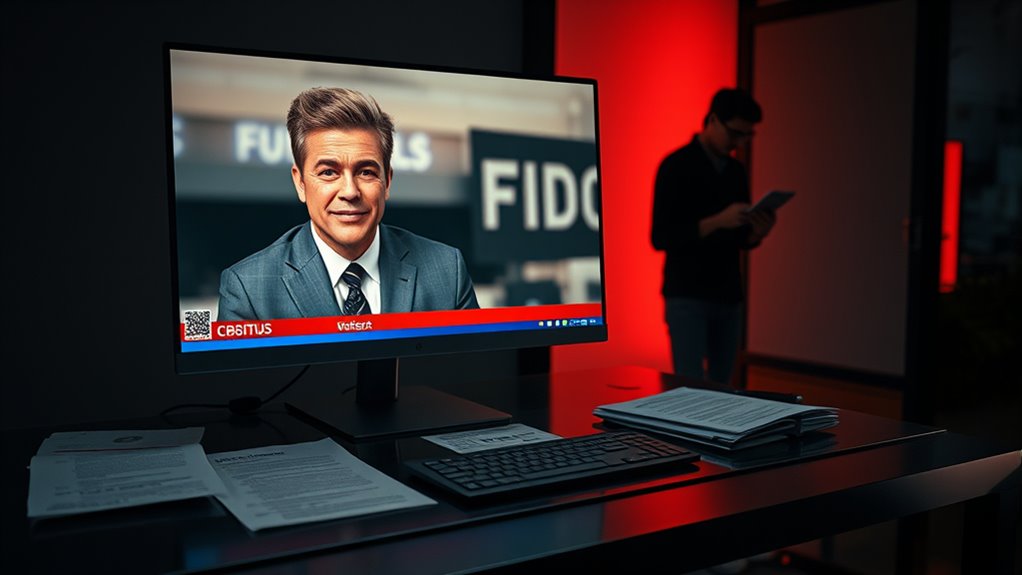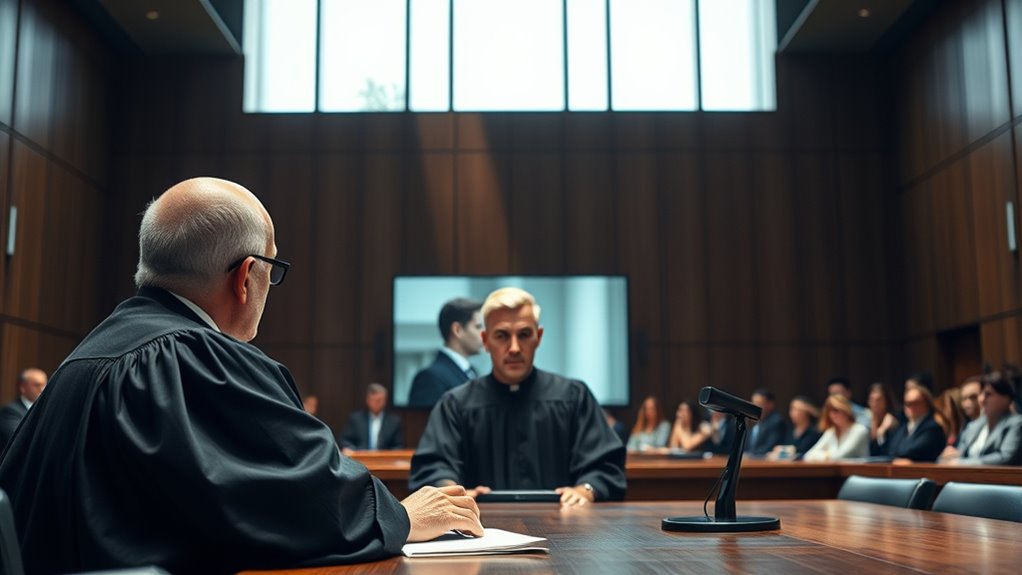Celebrity deepfakes create tricky legal issues you might not realize, like violations of privacy, publicity rights, and intellectual property. They can falsely depict stars endorsing products or saying things they never did, risking lawsuits and reputation damage. Platforms struggle to regulate this content, and laws are still catching up. If you want to understand how these gray zones affect rights, responsibilities, and future rules, there’s more to uncover.
Key Takeaways
- Deepfakes can falsely depict celebrities endorsing products, infringing on their rights of publicity and causing reputational harm.
- Ownership and licensing of manipulated celebrity content are legally ambiguous, leading to disputes over rights and consent.
- Cross-border jurisdictional issues complicate enforcement against unauthorized deepfake use of celebrities’ images.
- Existing laws often lag behind technology, creating legal grey zones for consent, privacy violations, and content moderation.
- Regulation gaps and detection challenges make it difficult to prevent malicious deepfakes impacting celebrities’ privacy and reputation.
The Intersection of Deepfake Technology and Celebrity Rights

As deepfake technology becomes more advanced, it raises significant concerns about the rights of celebrities. When used without consent, deepfakes can falsely portray celebrities endorsing products or taking part in campaigns, undermining their control over their image. This can damage their reputation and mislead fans, affecting fan engagement and trust. Brands may exploit deepfakes to create artificial celebrity endorsements, blurring the line between genuine promotion and manipulation. For celebrities, this means losing autonomy over how their likeness is utilized, which can lead to legal battles and emotional distress. Protecting celebrity rights in this digital age requires clear regulations to prevent unauthorized use and ensure that their image isn’t exploited to deceive fans or promote products without approval. Additionally, addressing digital identity issues is crucial to safeguarding their personal and professional integrity.
Intellectual Property Challenges in Deepfake Content

Deepfake technology presents complex intellectual property challenges because it allows creators to manipulate and reproduce a person’s likeness or voice without their permission. You might face authorship disputes when determining who owns the rights to the manipulated content—whether it’s the creator, the individual depicted, or a third party. Licensing complexities also arise, as existing agreements may not clearly cover synthetic recreations or alterations. This ambiguity complicates the legal landscape, making it difficult to enforce rights or establish clear ownership. You need to navigate these issues carefully, understanding that traditional intellectual property laws may not fully address the nuances of deepfake content. For example, Dog names can sometimes be part of branding disputes when used in deepfake advertisements, adding another layer of complexity. As a result, creators and rights holders often find themselves in grey areas, uncertain of their legal standing or enforcement options.
Privacy Violations and the Right to Publicity

Since deepfake technology can easily generate highly realistic images and videos of individuals without their consent, it poses significant privacy infringement and consent violations. When celebrities’ likenesses are used without permission, it breaches their right to publicity, which protects against unauthorized commercial use. These deepfakes can deceive viewers into believing celebrities endorse products or participate in scenarios they never agreed to, damaging their reputation and personal privacy. As a result, you face the risk of your image being exploited without your knowledge or consent. This invasion of privacy undermines your control over your own likeness and raises legal questions about consent and ownership. Deepfake-induced privacy violations highlight the urgent need for clear legal protections to safeguard individual rights. Additionally, the lack of regulation surrounding content moderation allows such violations to proliferate unchecked, further complicating efforts to protect personal privacy.
Defamation Risks Posed by Celebrity Deepfakes

You might find yourself questioning how deepfakes can harm a celebrity’s reputation if they falsely appear in damaging contexts. These videos can easily spread misinformation, leading to serious reputational damage. Additionally, it’s often unclear who bears legal responsibility when such deepfakes cause harm. The potential for misuse is heightened by the lack of regulation surrounding emerging home theatre projector technologies, making enforcement and accountability even more complicated.
Damage to Reputation
The rise of celebrity deepfakes has considerably increased the risk of reputational damage, as malicious actors can craft realistic but false videos that tarnish a public figure’s image. When these deepfakes spread, they can undermine a celebrity’s credibility, especially if they appear in scenarios damaging to their character. Such videos can also jeopardize celebrity endorsements, as brands may distance themselves from individuals involved in controversial or scandalous content. Additionally, the fan community’s trust can erode if followers believe the false videos are authentic, leading to lasting harm to the celebrity’s reputation. This ripple effect can cause emotional distress, lost opportunities, and long-term damage to their public image, highlighting the urgent need for awareness and protective measures against deepfake-related reputation attacks.
Legal Responsibility Challenges
Legal responsibility for celebrity deepfakes presents complex challenges, especially when it comes to defamation claims. Determining who’s liable becomes tricky in cases involving contract enforcement and jurisdiction disputes. You might find it hard to pinpoint the responsible party, whether it’s the creator, platform, or distributor. Different jurisdictions have varying laws, making enforcement difficult across borders. For example:
| Issue | Impact |
|---|---|
| Contract Enforcement | Difficult to hold parties accountable internationally |
| Jurisdiction Disputes | Legal conflicts delay justice and complicate cases |
| Defamation Claims | Proving intent and harm is complex in deepfake cases |
These hurdles complicate legal actions, leaving celebrities vulnerable to unchecked misuse and uncertain legal recourse.
Legal Actions and Precedents in Deepfake Cases

As deepfake technology becomes more widespread, courts are increasingly confronting cases that challenge existing legal frameworks. You’ll find that many legal actions revolve around consent requirements, as individuals seek to protect their likenesses from unauthorized use. Courts have also dealt with jurisdiction disputes, especially when deepfake content crosses state or national boundaries. In some cases, plaintiffs argue that their rights were violated under privacy or publicity laws, while others pursue copyright claims. Precedents are still emerging, but courts have started to recognize the potential harms caused by deepfakes, leading to rulings that set important legal standards. These cases highlight the need for updated laws to address the unique challenges deepfake technology presents. Additionally, legal professionals are beginning to explore how divorce laws might intersect with issues of digital impersonation and privacy violations involving deepfakes.
The Role of Platform Policies and Content Moderation

You rely on platform policies to keep deepfake content in check, but enforcement isn’t always consistent. Many platforms face challenges in moderating rapidly evolving technologies and detecting malicious videos. These gaps can allow harmful celebrity deepfakes to slip through, undermining efforts to protect individuals and the public.
Platform Policies Enforcement
Platform policies play a crucial role in regulating celebrity deepfakes by setting clear guidelines for acceptable content and establishing procedures for enforcement. To combat issues like algorithm bias, platforms need to refine detection algorithms that accurately identify manipulated videos without unfairly penalizing legitimate content. Enforcing policies also depends on respecting user consent; platforms must ensure users are aware of how their likenesses are used and have options to opt out. When policies are clearly defined, enforcement becomes more consistent, reducing the spread of harmful deepfakes. Additionally, understanding the importance of appliance testing and compatibility can help in assessing the reliability of content and ensuring safety standards are maintained. However, balancing free expression with protection requires ongoing updates to policies, along with transparent procedures for removing non-compliant content and penalizing violators. Effective enforcement ultimately relies on a combination of technological tools and a proactive moderation approach.
Moderation Challenges and Gaps
While platform policies aim to regulate celebrity deepfakes, significant moderation challenges persist that hinder effective enforcement. Automated detection tools struggle to accurately identify all deepfake content, especially as creators develop more sophisticated techniques to evade detection. This leaves many videos unflagged and accessible to the public. Additionally, relying solely on automated systems can lead to false positives, unfairly penalizing legitimate content. User reporting becomes a critical supplement, but it’s often inconsistent or delayed, allowing harmful deepfakes to remain online longer than they should. These gaps reveal the difficulty platforms face in balancing swift moderation with accuracy. Without continuous improvements in detection technology and better user engagement, the spread of problematic celebrity deepfakes remains a persistent issue. Moreover, the detection algorithms currently in use are often vetted and may require ongoing updates to keep pace with evolving deepfake creation techniques.
Emerging Legislation Addressing Deepfake Misuse

As concerns about the malicious use of deepfakes grow, lawmakers around the world are rushing to develop and implement legislation to combat this emerging threat. Many new laws focus on ensuring AI authenticity, requiring digital signatures on manipulated content to verify origin and prevent fraud. These signatures act as digital certificates, confirming a video or image’s authenticity and discouraging malicious creation. Countries are also exploring regulations that hold creators accountable for deepfakes intended to deceive, especially in political or celebrity contexts. By establishing clear legal standards and technological safeguards, governments aim to deter misuse and protect individuals’ rights. Additionally, understanding the emotional dynamics involved in digital deception can help inform regulatory approaches and ethical guidelines. While these laws are still evolving, their goal is to balance innovation with accountability, making deepfake technology less vulnerable to harmful applications.
Ethical Considerations and Future Legal Frameworks

The rapid development of legislation addressing deepfake misuse raises important questions about the ethical boundaries of AI-generated content. You face moral dilemmas around consent, privacy, and manipulation, which challenge societal norms. As technology advances, it’s vital to establish future legal frameworks that balance innovation with ethical responsibility. You must consider how deepfakes impact public trust, individual rights, and societal values. Creating clear guidelines can help prevent harm while allowing creative uses of AI. However, you also need to address the gray areas where legality and morality intersect. By proactively shaping policies, you can ensure that deepfake technology serves society positively, rather than fueling misinformation or exploitation. Additionally, understanding the diverse design options and sustainable materials used in innovative Vetted – Grobal World products can inspire responsible advancements in AI and related fields. Ultimately, your role involves safeguarding ethical standards as the technology continues to evolve.
Frequently Asked Questions
Can Celebrities Legally Control Their Images After Death?
You might wonder if celebrities can control their images after death. In most cases, their celebrity estate rights determine posthumous image control. These rights can give the estate authority to manage, reproduce, or restrict the use of their likeness. However, laws vary by jurisdiction, so the extent of control isn’t always clear. Ultimately, the estate holds the power to shape the legacy and protect the celebrity’s image after they’re gone.
Are Deepfakes Protected Under Free Speech Laws?
Imagine a world where your face can be swapped or manipulated at will—deepfakes blur that line, raising serious privacy concerns. You might think free speech laws protect such expressions, but technological challenges make it complex. Courts are still debating whether deepfakes fall under free speech, or if they infringe on personal rights. As this gray zone evolves, you need to stay aware of how legal boundaries are shifting around this powerful, yet risky, technology.
How Do International Laws Address Cross-Border Deepfake Violations?
International laws struggle to address cross-border deepfake violations due to digital sovereignty and jurisdictional conflicts. You’ll find that different countries have varying rules, making enforcement complicated. When a deepfake crosses borders, it’s hard to determine which nation’s laws apply. This creates gaps in accountability, leaving victims without clear legal recourse. To combat this, you need stronger international cooperation and agreements that respect digital sovereignty while establishing consistent standards.
What Are the Penalties for Creating Malicious Celebrity Deepfakes?
You could face serious penalties if you create malicious celebrity deepfakes, especially if you violate consent laws or engage in harmful image manipulation. Laws vary by jurisdiction but often include fines, criminal charges, or civil lawsuits. Creating deepfakes without consent can lead to reputational damage and legal action. Always understand local regulations; respecting consent laws helps prevent legal consequences and protects individuals’ rights from malicious deepfake misuse.
Can Deepfake Technology Be Used as Evidence in Court Cases?
You might wonder if deepfake technology can serve as evidence in court cases. It can, but you need to ensure privacy rights and intellectual property issues. Courts evaluate the authenticity of digital evidence, so you must verify whether the deepfake was manipulated to mislead or infringe on rights. Proper authentication ensures it’s admissible, but ethical concerns around privacy and IP remain, making its use complex and often contested.
Conclusion
As you navigate this evolving landscape, remember that over 96% of deepfakes go undetected, putting celebrities’ rights at serious risk. You have the power to demand stronger laws, ethical standards, and platform accountability. By staying informed and vigilant, you can help protect privacy, reputation, and creative integrity in this digital age. Together, we can push for a future where technology serves fairness, not harm.









